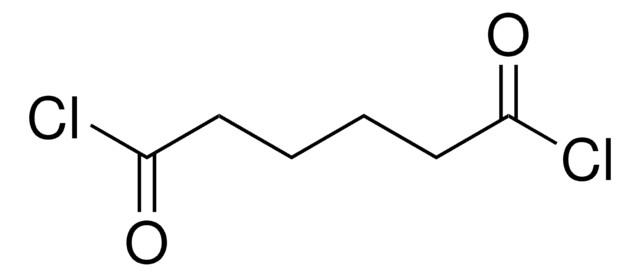13-0730
Hexamethylenediamine
SAJ first grade, ≥98.0%
Synonyme(s) :
1,6-Diaminohexane, 1,6-Hexanediamine, HMDA
About This Item
Produits recommandés
Qualité
SAJ first grade
Densité de vapeur
4 (vs air)
Essai
≥98.0%
Forme
solid
Limite d'explosivité
6.3 %
Disponibilité
available only in Japan
Indice de réfraction
n20/D 1.439 (lit.)
pH
12.4 (25 °C, 100 g/L)
Pf
42-45 °C (lit.)
Densité
0.89 g/mL at 25 °C (lit.)
Chaîne SMILES
NCCCCCCN
InChI
1S/C6H16N2/c7-5-3-1-2-4-6-8/h1-8H2
Clé InChI
NAQMVNRVTILPCV-UHFFFAOYSA-N
Vous recherchez des produits similaires ? Visite Guide de comparaison des produits
Mention d'avertissement
Danger
Mentions de danger
Conseils de prudence
Classification des risques
Acute Tox. 4 Dermal - Acute Tox. 4 Oral - Eye Dam. 1 - Skin Corr. 1B - STOT SE 3
Organes cibles
Respiratory system
Code de la classe de stockage
8A - Combustible corrosive hazardous materials
Classe de danger pour l'eau (WGK)
WGK 1
Point d'éclair (°F)
176.0 °F - closed cup
Point d'éclair (°C)
80 °C - closed cup
Équipement de protection individuelle
Eyeshields, Faceshields, Gloves, type P3 (EN 143) respirator cartridges
Faites votre choix parmi les versions les plus récentes :
Déjà en possession de ce produit ?
Retrouvez la documentation relative aux produits que vous avez récemment achetés dans la Bibliothèque de documents.
Notre équipe de scientifiques dispose d'une expérience dans tous les secteurs de la recherche, notamment en sciences de la vie, science des matériaux, synthèse chimique, chromatographie, analyse et dans de nombreux autres domaines..
Contacter notre Service technique








